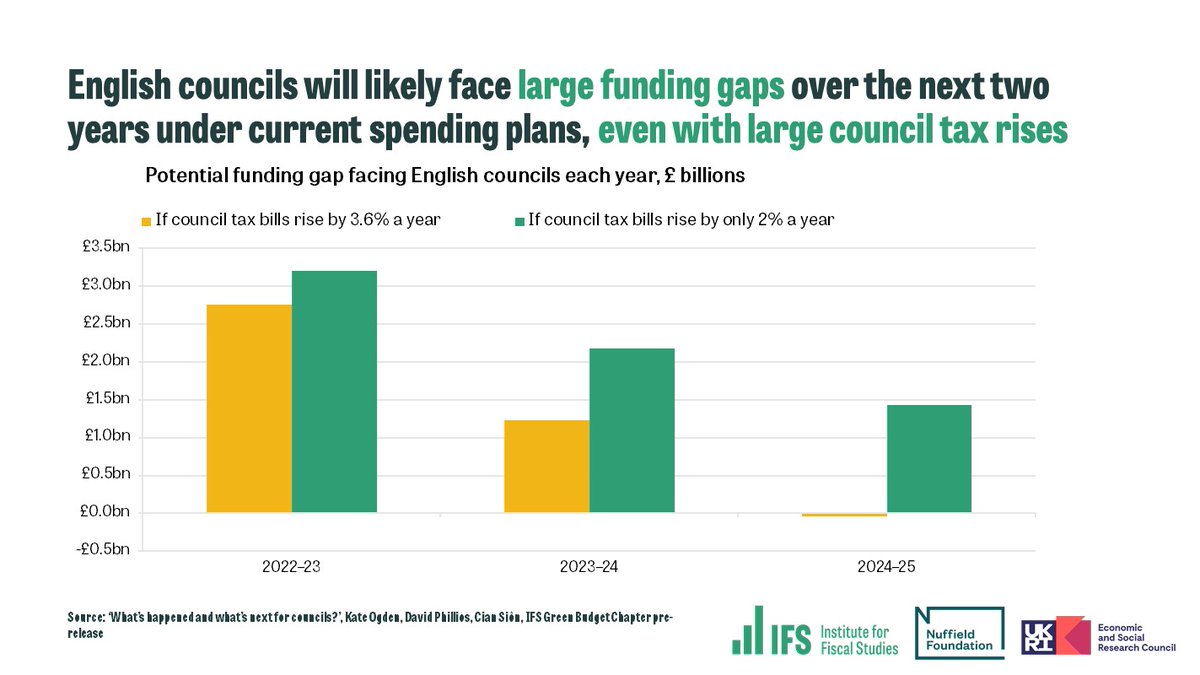Discover and read the best of Twitter Threads about #ifsgreenbudget
Most recents (5)
Chancellor @KwasiKwarteng has promised a 'fully costed plan to get debt falling in the medium-term’.
But stabilising debt as a fraction of national income in 2026–27 would require a fiscal tightening of around £60bn on @Citibank’s central forecast.
[#IFSGreenBudget THREAD: 1/8]
But stabilising debt as a fraction of national income in 2026–27 would require a fiscal tightening of around £60bn on @Citibank’s central forecast.
[#IFSGreenBudget THREAD: 1/8]

Debt in our central forecast with @Citibank continues to rise throughout the forecast horizon, even once the big packages of support for rising energy prices are assumed to have expired.
[2/8]
[2/8]

NEW: For every £1 given to households through the high-profile cuts to taxes, £2 is being taken away in the stealthy freezes to tax and benefit thresholds.
Read @TomWatersEcon and Tom Wernham’s @NuffieldFound-funded #IFSGreenBudget chapter> ifs.org.uk/publications/r…
THREAD: [1/8]
Read @TomWatersEcon and Tom Wernham’s @NuffieldFound-funded #IFSGreenBudget chapter> ifs.org.uk/publications/r…
THREAD: [1/8]
Alongside the headline tax cuts (to the basic rate of income tax & NICs) various thresholds and amounts in the tax-benefit system are being frozen.
This is raising the tax burden and reducing the size of the benefit system in real terms – especially when inflation is high [2/8]
This is raising the tax burden and reducing the size of the benefit system in real terms – especially when inflation is high [2/8]
NEW: In the absence of official scrutiny from @OBR_UK alongside Friday's announcement, we've provided our own #IFSGreenBudget fiscal forecasts with @citibank.
We find that planned tax cuts with stalling economic growth would leave debt on an unsustainable path.
THREAD: 1/13
We find that planned tax cuts with stalling economic growth would leave debt on an unsustainable path.
THREAD: 1/13

It is disappointing that Friday’s statement won't be accompanied by new official forecasts from @OBR_uk.
These would have shown that a combination of a weaker outlook for the economy and substantial tax cuts will lead to more borrowing and more debt.
[2/13]
These would have shown that a combination of a weaker outlook for the economy and substantial tax cuts will lead to more borrowing and more debt.
[2/13]

.@Citibank’s forecasts show an improved outlook for economic growth from the @bankofengland’s August forecast.
But it is still a far worse performance than forecast by @OBR_uk in March.
[3/13]
But it is still a far worse performance than forecast by @OBR_uk in March.
[3/13]

NEW: English #councils will need billions more from government and big #counciltax rises just to maintain services at their pre-COVID levels.
Read our #IFSGreenBudget chapter on local government funding, funded by @NuffieldFound > ifs.org.uk/publications/1…
Read our #IFSGreenBudget chapter on local government funding, funded by @NuffieldFound > ifs.org.uk/publications/1…

NEW: The past 40 years shows NHS spending plans are almost always topped up.
If history repeats itself, the ‘temporary’ increases in NHS funding could end up permanently swallowing up the money raised by the tax rise, leaving little for social care.
ifs.org.uk/publications/1…
If history repeats itself, the ‘temporary’ increases in NHS funding could end up permanently swallowing up the money raised by the tax rise, leaving little for social care.
ifs.org.uk/publications/1…

The extra funding provided for the NHS in yesterday's announcement will result in spending growing at 3.9% a year between 2018−19 and 2024−25.
This is exactly the same rate of growth as was planned between 2018−19 and 2023−24.
This is exactly the same rate of growth as was planned between 2018−19 and 2023−24.
This suggests little in the way of virus-related spending after 2024.
A future top up could be required – but even without one, health spending is set to account for an ever-growing share of total day-to-day public service spending: 44% by 2024−25, up from 27% in 1999−00.
A future top up could be required – but even without one, health spending is set to account for an ever-growing share of total day-to-day public service spending: 44% by 2024−25, up from 27% in 1999−00.




